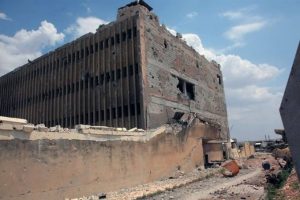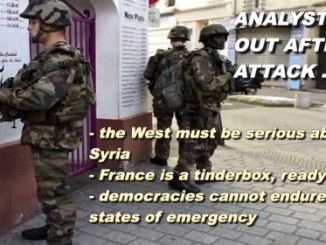
Hearsay Extrapolated – Amnesty Claims Mass Executions In Syria, Provides Zero Proof
Moon of Alabama
A new Amnesty International report claims that the Syrian government hanged between 5,000 and 13,000 prisoners in a military prison in Syria. The evidence for that claim is flimsy, based on hearsay of anonymous people outside of Syria. The numbers themselves are extrapolations that no scientist or court would ever accept. It is tabloid reporting and fiction style writing from its title “Human Slaughterhouse” down to the last paragraph.
But the Amnesty report is still not propagandish enough for the anti-Syrian media. Inevitably only the highest number in the range Amnesty claims is quoted. For some even that is not yet enough. The Associate Press agency, copied by many outlets, headlines: Report: At least 13,000 hanged in Syrian prison since 2011:
BEIRUT (AP) — Syrian authorities have killed at least 13,000 people since the start of the 2011 uprising in mass hangings at a prison north of Damascus known to detainees as “the slaughterhouse,” Amnesty International said in a report Tuesday.
How does “at least 13,000” conform to an already questionable report which claims “13,000” as the top number of a very wide range?
Here is a link to the report.
 Before we look into some details this from the “Executive Summary”:
Before we look into some details this from the “Executive Summary”:
From December 2015 to December 2016, Amnesty International researched the patterns, sequence and scale of violations carried out at Saydnaya Military Prison (Saydnaya) (pictured). In the course of this investigation, the organization interviewed 31 men who were detained at Saydnaya, four prison officials or guards who previously worked at Saydnaya, three former Syrian judges, three doctors who worked at Tishreen Military Hospital, four Syrian lawyers, 17 international and national experts on detention in Syria and 22 family members of people who were or still are detained at Saydnaya.
…
On the basis of evidence from people who worked within the prison authorities at Saydnaya and witness testimony from detainees, Amnesty International estimates that between 5,000 and 13,000 people were extrajudicially executed at Saydnaya between September 2011 and December 2015.
There are several difficulties with this report.
1. Most of the witnesses are identified as opposition figures and “former” officials who do not live in Syria. Some are said to have been remotely interviewed in Syria but it is not clear if those were living in government or insurgent held areas. Page 9:
The majority of these interviews took place in person in southern Turkey. The remaining interviews were conducted by telephone or through other remote means with interviewees still in Syria, or with individuals based in Lebanon, Jordan, European countries and the USA.
It is well known that the Syrian insurgency is financed with several billion dollars per years from foreign state governments. It runs sophisticated propaganda operations. These witnesses all seem to have interests in condemning the Syrian government. Not once is an attempt made to provide a possibly divergent view. Amnesty found the persons it questioned by contacting international NGOs like itself and known foreign financed opposition (propaganda) groups:
These groups include Urnammu for Justice and Human Rights, the Syrian Network for Human Rights, and the Syrian Institute for Justice and Accountability.
2. The numbers Amnesty provides are in a very wide range. None are documented in lists or similar exhibits. They are solely based on hearsay and guesstimates of two witnesses:
People who worked within the prison authorities at Saydnaya told Amnesty International that extrajudicial executions related to the crisis in Syria first began in September 2011. Since that time, the frequency with which they have been carried out has varied and increased. For the first four months, it was usual for between seven and 20 people to be executed every 10-15 days. For the following 11 months, between 20 and 50 people were executed once a week, usually on Monday nights. For the subsequent six months, groups of between 20 and 50 people were executed once or twice a week, usually on Monday and/or Wednesday nights. Witness testimony from detainees suggests that the executions were conducted at a similar – or even higher – rate at least until December 2015. Assuming that the death rate remained the same as the preceding period, Amnesty International estimates that between 5,000 and 13,000 people were extrajudicially executed at Saydnaya between September 2011 and December 2015.
From “between x and y”, “once or twice a week”, “suggests” and “assuming” the headline numbers are simply extrapolated in footnote 40 in a back-of-the-envelope calculation “If A were true then B would be X”:
These estimates were based on the following calculations. If between seven and 20 were killed every 10-15 days from September to December 2011, the total figure would be between 56 people and 240 people for that period. If between 20 and 50 were killed every week between January and November 2012, the total figure would be between 880 and 2,200 for that period. If between 20 and 50 people were killed in 222 execution sessions (assuming the executions were carried out twice a week twice a month and once a week once a month) between December 2012 and December 2015, the total figure would be between 4,400 and 11,100 for that period. These calculations produce a minimum figure of 5,336, rounded down to the nearest thousand as 5,000, and 13,540, rounded down to the nearest thousand as 13,000.
2. I will not go into the details of witness statements on which the report is build. They seem at least exaggerated and are not verifiable at all. In the end it is pure hearsay on which Amnesty sets it conclusions. One example from page 25:
“Hamid”, a former military officer when he was arrested in 2012, recalled the sounds he heard at night during an execution:
“There was a sound of something being pulled out – like a piece of wood, I’m not sure – and then you would hear the sound of them being strangled… If you put your ears on the floor, you could hear the sound of a kind of gurgling. This would last around 10 minutes… We were sleeping on top of the sound of people choking to death. This was normal for me then.”
A court might accept ‘sound of “I’m not sure” “kind of gurgling” noise through concrete’ as proof that a shower was running somewhere. But as proof of executions?
Of all the witnesses Amnesty says it interviewed only two, a former prison official and a former judge, who describe actual executions (page 25). From the wording of their statements it is unclear if they have witnessed any hangings themselves or just describe something they have been told of.
3. The numbers of people Amnesty claims were executed are – at best – a wild ass guess. How come that Amnesty can name only very few of those? On page 30 of its report it says:
Former detainees from the red building at Saydnaya provided Amnesty International with the names of 59 individuals who they witnessed being taken from their cells in the afternoon, being told that they were being transferred to civilian prisons in Syria. The evidence contained in this report strongly suggests that in fact, these individuals were extrajudicially executed.
and
Former prison guards and a former prison official from Saydnaya also provided Amnesty International with the names of 36 detainees who had been extrajudicially executed in Saydnaya since 2011.
Those 95, some of whom may have been “executed” – or not, are the only ones Amnesty claims to be able to name. That is less than 1-2% of the reports central claim of 5,000 to 13,000 executed. All those witnesses could provide no more details of persons allegedly killed?
Amnesty acknowledges that its numbers are bogus. Under the headline “Documented Deaths” on page 40 it then adds additional names and numbers to those above, but these are not from executions:
the exact number of deaths in Saydnaya is impossible to specify. However, the Syrian Network for Human Rights has verified and shared with Amnesty International the names of 375 individuals who have died in Saydnaya as a result of torture and other ill-treatment between March 2011 and October 2016. Of these, 317 were civilians at the time of their arrest, 39 were members of the Syrian military and 19 were members of non-state armed groups. In the course of the research for this report, Amnesty International obtained the names of 36 additional individuals who died as a result of torture and other ill-treatment in Saydnaya. These names were provided to Amnesty International by former detainees who witnessed the deaths in their cells
 The “Syrian Network for Human Rights” (SNHR) is a group in the UK probably connected to British foreign intelligence and with dubious monetary sources. It only says:
The “Syrian Network for Human Rights” (SNHR) is a group in the UK probably connected to British foreign intelligence and with dubious monetary sources. It only says:
SNHR funds its work and activities through unconditional grants and donations from individuals and institutions.
Now that is true transparency.
SNHR is known for rather ridiculous claims about casualties caused by various sides of the conflict. It is not know what SNHR qualifies as civilians – do these include armed civil militia? But note that none of the mostly civilians SNHR claims to have died in the prison are said to have been executed. How is it possible that an organization frequently quoted in the media as detailed source of casualties in Syria has no record of the 5,000 to 13,000 Amnesty claims were executed?
4. The report is padded up with before/after satellite pictures of enlarged graveyards in Syria. It claims that these expansions are a sign of mass graves of government opponents. But there is zero evidence for that. Many people have died in Syria throughout the war on all sides of the conflict. The enlargement, for example, of the Martyrs Cemetery south of Damascus (p.29/30) is hardly a sign of mass killing of anti-government insurgents. Would those be honored as martyrs by the government side?
5. The report talks of “extrajudicially executed” prisoners but then describes (military) court procedures and a necessary higher up approval of the judgement. One may not like the laws that govern the Syrian state, but the courts and the procedures Amnesty describes seem to follow Syrian laws and legal processes. They are thereby – by definition – not extrajudicial.
6. In its Executive Summary the Amnesty report says that “Death sentences are approved by the Grand Mufti of Syria and …”. But there is no evidence provided of “approval” by the Grand Mufti (pictured) in the details of the report. On page 19 it claims, based on two former prison and court officials:
The judgement is sent by military post to the Grand Mufti of Syria and to either the Minister of Defence or the Chief of Staff of the Army, who are deputized to sign for Syrian President Bashar al-Assad and who specify the date of the execution.
 It is very doubtful that the Syrian government would “deputize” or even inform the Grand Mufti in cases of military or criminal legal proceedings. Amnesty International may dislike the fact but Syria is a secular state. The Grand Mufti in Syria is a civil legal authority for some followers of the Sunni Muslim religion in Syria but he has no official judiciary role. From the 2010 Swiss dissertation Models of Religious Freedom: Switzerland, the United States, and Syria quoted here:
It is very doubtful that the Syrian government would “deputize” or even inform the Grand Mufti in cases of military or criminal legal proceedings. Amnesty International may dislike the fact but Syria is a secular state. The Grand Mufti in Syria is a civil legal authority for some followers of the Sunni Muslim religion in Syria but he has no official judiciary role. From the 2010 Swiss dissertation Models of Religious Freedom: Switzerland, the United States, and Syria quoted here:
In Syria a mufti is a legal and religious expert (faqih and ‘alim) who has the power to give legally non-binding recommendations (sing. fatwa, pl. fatawa) in matters of Islamic law.
…
Queries which are either sought by a shari‘a judge or private individuals regard the personal status laws of the Muslim community only. In the Arab Republic fatawa are given neither to public authorities nor to individual civil servants, ..
Neither the Syrian constitution nor any Syrian law I can find refers to a role of the Grand Mufti in any military or civil criminal court proceding. The Amnesty claim “approved by the Grand Mufti of Syria”is not recorded anywhere else. It is very likely false. The Grand Mufti, Sheikh Ahmad Badreddin Hassoun, is a moderate, recognized and accomplished scholar. He should sue Amnesty for this slander.
Syrian law includes a death penalty for certain severe and violent crimes. Before 2011 actual executions in Syria were very rare: most death sentences were commuted. Allegedly the laws were amended in late 2011, after the war in Syria had started, to include the death penalty as possible punishment for directly arming terrorists.
It is quite likely that the Syrian military and/or civil judiciary hand out some death penalties against captured foreign and domestic “rebels” it finds them guilty of very severe crimes. It is fighting the Islamic State, al Qaeda and other extreme groups well known for mass murder and other extreme atrocities. It is likely that some of those sentences are applied. But the Syrian government has also provided amnesty to ten-thousands of “rebels” who fought the government but have laid down their arms.
The claims in the Amnesty report are based on spurious and biased opposition accounts from outside of the country. The headline numbers of 5,000 to 13,000 are calculated on the base of unfounded hypotheticals. The report itself states that only 36 names of allegedly executed persons are known to Amnesty, less than the number of “witnesses” Amnesty claims to have interviewed. The high number of claimed executions together with the very low number of names is not plausible.
The report does not even meet the lowest mark of scientific or legal veracity. It is pure biased propaganda.
Note: An earlier version of this piece mixed up the Syrian Network for Human Rights (SNHR) and the Syrian Observatory for Human Rights (SOHR). Both are registered in the UK and claim to provide accurate casualty data from Syria. Only SNHR is referenced in this Amnesty report.
************
ER recommends other articles by Strategic Culture Foundation, and Moon of Alabama where this article originally appeared
 Find out about our great (WOW) TLB Project Membership package and benefits, add your voice and help us to change the world!
Find out about our great (WOW) TLB Project Membership package and benefits, add your voice and help us to change the world!




